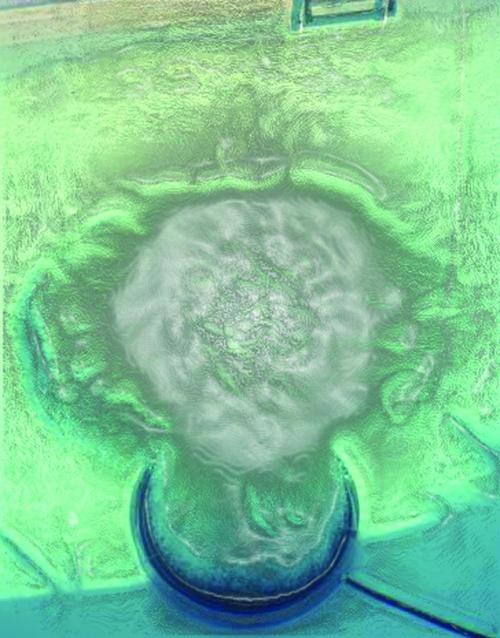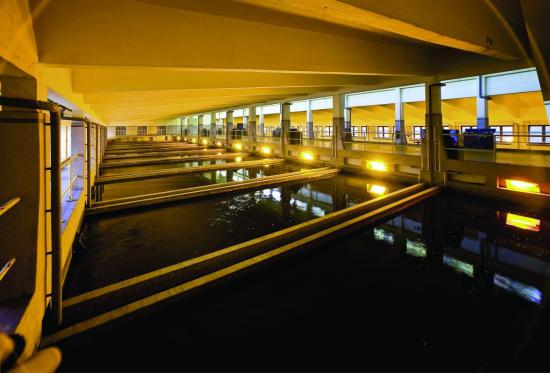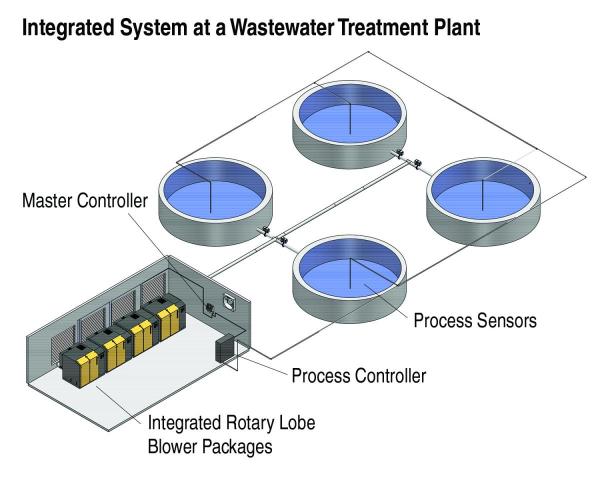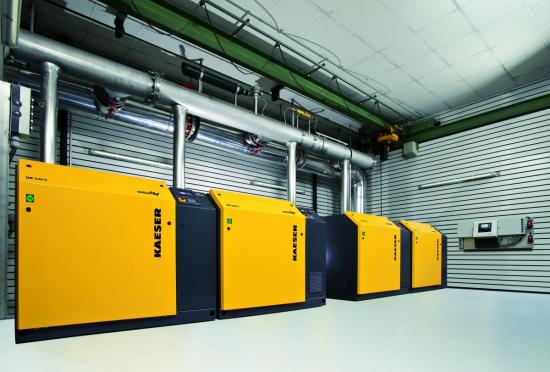The overall wastewater treatment process is complex, and each step is integral to ensuring water is properly purified. Effluent ends up in the plants, containing substances that must be removed before the water can be properly cleaned and returned for use. The range of potential contaminants is almost endless and can include food, pulp, waste, or other substances. Afterwards, the water requires further scrubbing, with the aid of bacteria. It is in this part of the process that compressed air (ideally provided by energy-efficient rotary lobe blowers) plays a vital role.
Blower air is an indispensable part of biological wastewater treatment plant (WWTP) processes. Integration — on the blower package level as well as the system level — is key to maximizing energy efficiency and ensuring that this critical service is readily available for the communities the WWTP serves.
Defining the Demands of a Wastewater Treatment Plant
Wastewater treatment plants mirror the biological self-cleaning process occurring in natural waters — albeit faster than Mother Nature. Bacteria are added to the wastewater at the start of the process in order to speed up clarification. These microscopic assistants take care of the cleaning work, but need oxygen to thrive and survive. Without air, there is no life, and in the end, no clean water. Oxygenation in wastewater plants is carried out by injecting streams of fine air bubbles through the water. The best approach to oxygenation is to employ the tried-and-true method of using compressed air generated by rotary blowers because this application normally requires a gauge pressure of only approximately 500 mbar (7.25 psi).
Rotary lobe blowers are positive displacement machines and displace air rather than compress it. As a result, the pressure generated is no higher than actually needed. In other words, there is no over-compression or generation of unnecessarily high pressure. After all, greater pressure means greater costs. Since energy is the single highest operating cost in a wastewater treatment plant — with the energy to operate blowers for aeration being the largest energy consumer — it pays to be efficient.

Figure 1: Oxygenation plays a critical role in the wastewater treatment process (Image courtesy of ADS).
Ensuring a dependable source of compressed air at all times is also absolutely critical. The wastewater treatment plant's biological processes require large amounts of oxygen in constant supply. The success of the water purification process depends entirely on continuity: microorganisms can only perform their work if their life cycle is uninterrupted. Simply put, if their air supply is cut off, the bacteria die. And any interruption leads to a breakdown in the clarification process. If this happens, the bacteria culture must be rebuilt from scratch. This is why it is especially important that the blowers used in the aeration process provide absolute reliability.
Given the demands of wastewater treatment plants and the importance of aeration to their processes, an ideal blower package should be energy efficient and reliable. But what is the best way to ensure efficiency and reliability? The key is integration — in terms of the individual blower packages as well as the system as a whole.
From Piecemeal Assembly to All-in-One Engineering
Historically, blower packages for the aeration portion of the wastewater treatment plant have been assembled with a piecemeal approach. Using this method, numerous individual components are separately sourced and selected from multiple vendors and assembled into a single blower package. Primarily, the focus was on component requirements, and little regard was paid to how the different components actually worked together. These highly customized packages made the quoting and bidding processes a nightmare. Since the individual pieces were not assembled and tested together, it was utterly impossible to clearly see how efficient these “Frankenstein” blower packages truly were.
Power losses and flow restrictions from blower blocks, silencers, filters, valves, pumps, fans, and drives all impact energy efficiency — not to mention the power consumers in the control panel. Focusing only on the stated efficiency of each individual component does not take internal losses into account. Consequently, stated efficiencies do not paint an accurate picture of the blower package’s net power consumption. The focus on individual machine componentry as opposed to complete packages resulted in custom one-off machines with great performance variations from site to site.

Figure 2: Reliability and efficiency are chief concerns for wastewater treatment plants.
An Integrated Blower System is Greater Than the Sum of Its Parts
While this one-off engineering approach still happens today, the industry is moving towards package integration, or an all-in-one solution where a single manufacturer builds the complete blower unit. This offers many advantages, including significant time and money savings on specifying the individual components and drastically reduced installation costs since the package arrives fully assembled. Further, the manufacturer has pre-selected the individual components with guaranteed performance and efficiency values. The whole package is indeed greater than the sum of its parts. A completely assembled package also makes testing to industry package performance standards possible. This is a huge benefit to the specifier and end user, as they can now more easily and accurately compare performance between competitors. The Compressed Air and Gas Institute (CAGI) is streamlining the comparison process even further by developing performance data sheets for blowers — similar to what they have already done for compressors. This would mean participating blower manufacturers would publish performance values using the same data sheets, allowing true apples-to-apples performance comparisons that specifiers and end users can clearly see. Currently, the goal is to have the data sheets finalized this year.
New Innovations in Blower TechnologyBest Practices 2020 ONLINE EVENT Presentation RecordingPresenters: Julie Gass, P. E., Lead Mechanical Process Engineer, and Vishnu Guntupalli, P. Eng., Mechanical Engineer, Black & Veatch
|
Additional advances with blower package integration include onboard controls. Integrating this technology helps with energy efficiency as well as reliability. While controller capabilities vary from manufacturer to manufacturer, the most advanced options offer data storage for analyzing energy consumption, preventive maintenance reminders, and — perhaps most importantly —communications capabilities for integrating with plant control over a BUS network. Having this built-in capability means the blower package can seamlessly communicate with a wastewater treatment plant’s SCADA system. This permits precise blower control and the optimization of machine maintenance.

Figure 3: Package and system integration means wastewater treatment plants can track energy consumption and dissolved oxygen levels.
All Systems Go with Planned Integration
System integration offers even greater levels of energy efficiency and reliability. However, having the most energy-efficient blower packages will not deliver the anticipated efficiency gains if the blowers are not properly applied and controlled. If the blowers are not properly controlled, they can needlessly cycle, causing unnecessary wear and tear on the motor and valves. This, in turn, can lead to reduced reliability, causing unscheduled downtime and higher maintenance costs. System integration can have a meaningful impact on how the blower packages work together and contribute to the system’s efficiency and overall reliability.
Successful system integration begins with proper planning and careful equipment selection. When planning a rotary blower installation, it is important to consider not only the individual blowers, but also the system as a whole. It is well documented that selecting and installing optimally matched components yields considerable gains. This is why package integration is the foundation for building an efficient system. It is important to know how to control the individual units and when to turn them on and off so that they operate at the peak of their performance and efficiency. Piping, ventilation, and layout also contribute to the system’s overall performance. These additional factors are often overlooked, yet they contribute to efficiency as well. A poorly ventilated blower room, for example, will not circulate enough cooling air, causing high ambient temperatures and the blowers to overheat. This can lead to lower efficiencies, shut down, and even mechanical failure.

Figure 4: Multiple integrated blower packages controlled with a system master controller offer an energy-efficient and reliable solution for wastewater treatment plants.
Of course, this requires proper planning prior to installation, and it begins by understanding the true system demand. This approach helps with selecting the best-suited blowers for the application. The aim is to establish the blower station's optimum operating point with regards to energy use and to avoid designing the system to meet the needs of a very rare operating point that only occurs a few times a year. The blowers certainly need to be selected so that they can deliver the maximum amount of air required, but on the whole, they must ensure the best possible efficiency at the most common real-world operating point. The best solution can be determined using computer models that predict the efficiency of various suitable blower combinations and comparing them against one another with regards to maintenance costs.
Blower Controls Deliver Energy-Efficient Operation
The actual integration aspect comes from relying on a system master controller to properly control the individual blower packages. An advanced system master controller is programmed with the performance information of each blower, and it then selects the most efficient combination of blowers to meet the current demand. It can also rotate packages to balance load hours, spreading out preventive maintenance intervals. These advanced controllers can monitor both machine health and a specific system variable (in the case of a wastewater treatment plant, it is typically dissolved oxygen), and trigger an alarm if the variable falls below a specific threshold value. It’s even possible to send an email or text message to plant personnel to notify them of the alarm situation (system- or machine-related). Remote monitoring features open new avenues for system reliability — especially for installations in remote locations. System data is available in real time at the click of a mouse and can be analyzed for trending, predictive maintenance, and plant forecasting.
Now more than ever, wastewater treatment plants have the means to effectively design, install, and maintain an energy-efficient system that can reliably deliver the compressed air needed to ensure oxygenation is not interrupted. By embracing advances in blower technology and utilizing integration on both a blower package and system level, communities can rest assured that they will have a continuous and energy-efficient supply of clean water.
For more information, contact Stephen Horne, Blower Product Manager, Kaeser USA, tel: (540) 898-5500 or visit www.us.kaeser.com.
To read more about Wastewater Aeration, please visit /industries/wastewater.



